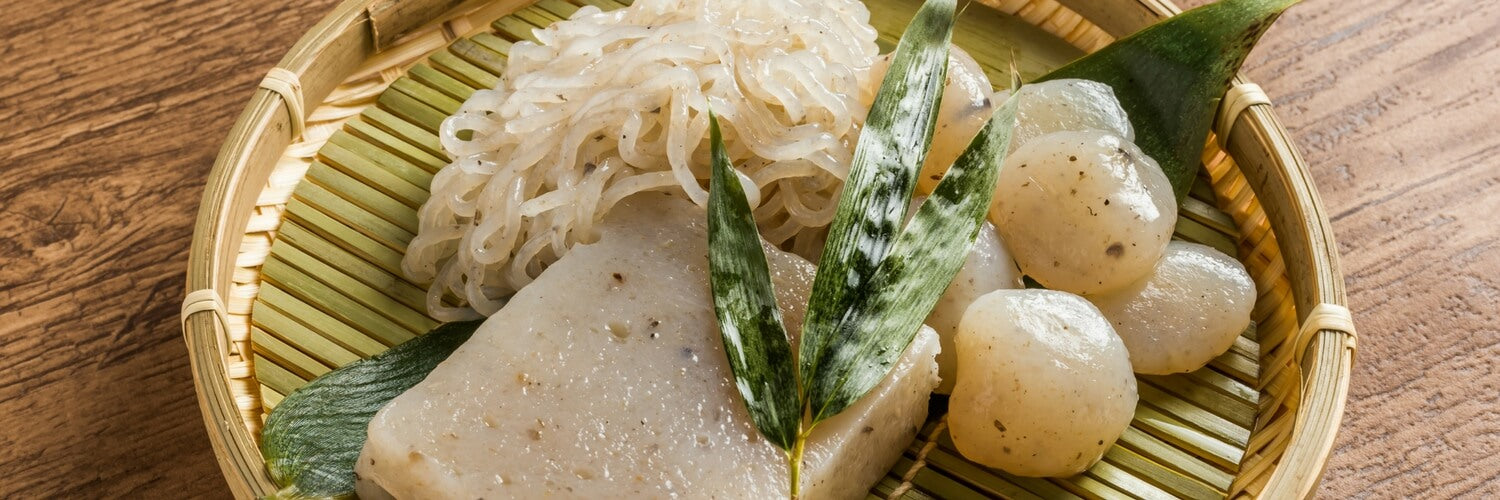
Konnyaku —The Strange Asian Vegetable & Traditional Japanese Delicacy
3 minutes
Konnyaku is an odd Japanese ingredient that doesn’t look especially appealing, but it’s very healthy ingredient indeed. It can be used in many culinary dishes as an alternative to carb-heavy ingredients.
At first glance, this light grey rubbery mass that sits on the plate may not look very appetizing. When it is served sliced amongst other vegetables or hidden beneath the broth and other ingredients of a stew, it is far less noticeable and alarming. Perhaps if it looked like some sort of jelly-like dessert, it could be less weird. Sadly, it is not a dessert.
In fact, those who are not familiar with how healthy this strange Asian vegetable actually is are likely to shy away from it. But once you discover more about konnyaku, you may be curious enough to try it. And once you try it, you may elect to add it to your diet more often.
What Exactly Is Konnyaku?
This Japanese delicacy actually begins as a humble potato-like vegetable, somewhat similar to taro, another Asian root vegetable. In potato form, referred to as a konjac, it doesn’t appear so questionable. But then it undergoes a process whereby it is softened and mixed with water, then dried and ground, and finally mixed with powdered seaweed, molded into the shape of a flat log, and boiled.
The end result is a gelatinous mass of grey cube with black dots. While this is its most common form, it can also come in the shape of noodles ranging in size from thin to thick. This kinds go well with various vegetables and proteins when cooked together. Or, it can come as small grey balls that are ideal for soups and stews. Appearances aside, konnyaku is actually an ideal ingredient for those seeking to lose weight.
Health Benefits of Konnyaku
Konnyaku is great for those seeking to lose weight, as it is high in a specific type of fiber called glucomannan, which aid in weight loss. Additionally, the whole block of konnyaku contains only about 10 calories. Moreover, because it is 97 percent water, it is very filling! It also contains some starch and protein and helps to aid in regulating blood sugar, cholesterol, and blood pressure.
In Japan, konnyaku is also referred to as “the broom of the stomach.”, as it helps to flush out your small intestines. In fact, Chinese medicine originally used it as a diuretic.
Culinary Uses of Konnyaku
Today, konnyaku isn’t just a medicinal remedy. You actually find it in a variety of Japanese dishes. In addition to the plain slabs of konnyaku you can purchase in Asian supermarkets, you might also find some with citrus or nori flavors.
Like tofu, konnyaku has very little flavor itself but absorbs the flavors of whatever other ingredients you’re cooking it with. As such, it is the perfect low-calorie, 0-carb ingredients to use in place of pasta and other fattening proteins or carb-heavy ingredients.
Before cooking konnyaku, slice it into the pieces you desire. Once cut, blanch it in boiling water for a few minutes, and then drain. This helps to eliminate an odd smell that accompanies konnyaku. When sauteing, stir-frying, or boiling, the longer it cooks with other ingredients, the more flavor it will absorb. Try a stew or a stir-fry for starters, and see what you think!
